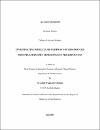INVESTIGATING MOLECULAR PATHWAYS OF ROS-INDUCED PRO-INFLAMMATORY SENESCENCE IN PREADIPOCYTES
| Advisor | Abumadi, Marawan |
| Author | Madani, Ayeshah Yaghoub |
| Available date | 2015-12-03T06:51:41Z |
| Publication Date | 2015-06 |
| Abstract | Obesity has been associated with chronic low-grade inflammation, which is considered to be a major cause for insulin resistance and type 2 diabetes (T2D). The therapeutic interventions for T2D are lacking due to the unclear understanding of the molecular mechanisms of obesity driven T2D. The ultimate focus of current project is to investigate and reveal the molecular mechanisms of this association to discover novel therapeutic targets for obese individuals living with diabetes. The adipose tissue in the obese state is characterized by the accumulation of reactive oxygen species (ROS), which will lead to DNA damage. The cell undergoes senescence, when the DNA is severely damaged and unable to be repaired. An increased secretion of pro-inflammatory cytokines characterizes senescent cells and it’s known as senescence associated secretory phenotype (SASP) as reported by in vitro and in vivo studies. The knowledge about SASP components and the determination of pro-inflammatory phenotype is lacking especially in obesity and T2D. The main goal of this study is to investigate the role of the novel transcription factors, including STAT1, DDIT3 and C/EBPδ, in pro-inflammatory senescence. A new role for the transcription factor STAT1 has been revealed in senescence. It seems to promote cell cycle via p21 pathway and regulates inflammation by affecting IL6 expression when encountered by genotoxic agent such as H2O2. These results will enhance our understanding about the molecular details that will help in the development of effective therapeutic interventions. |
| Sponsor | Qatar University (Project Reference: QUUG-CAS-DBES-13/14-14) and the BMRP funding of Dr. Mazloum at Weill Cornell Medical College-Qatar |
| Language | en |
| Subject | Obesity Diabetes therapy pro-inflammatory phenotype |
| Type | Master Thesis |
| Department | Health Sciences |
Files in this item
This item appears in the following Collection(s)
-
Health Sciences-CAS (pre 2016) [12 items ]



